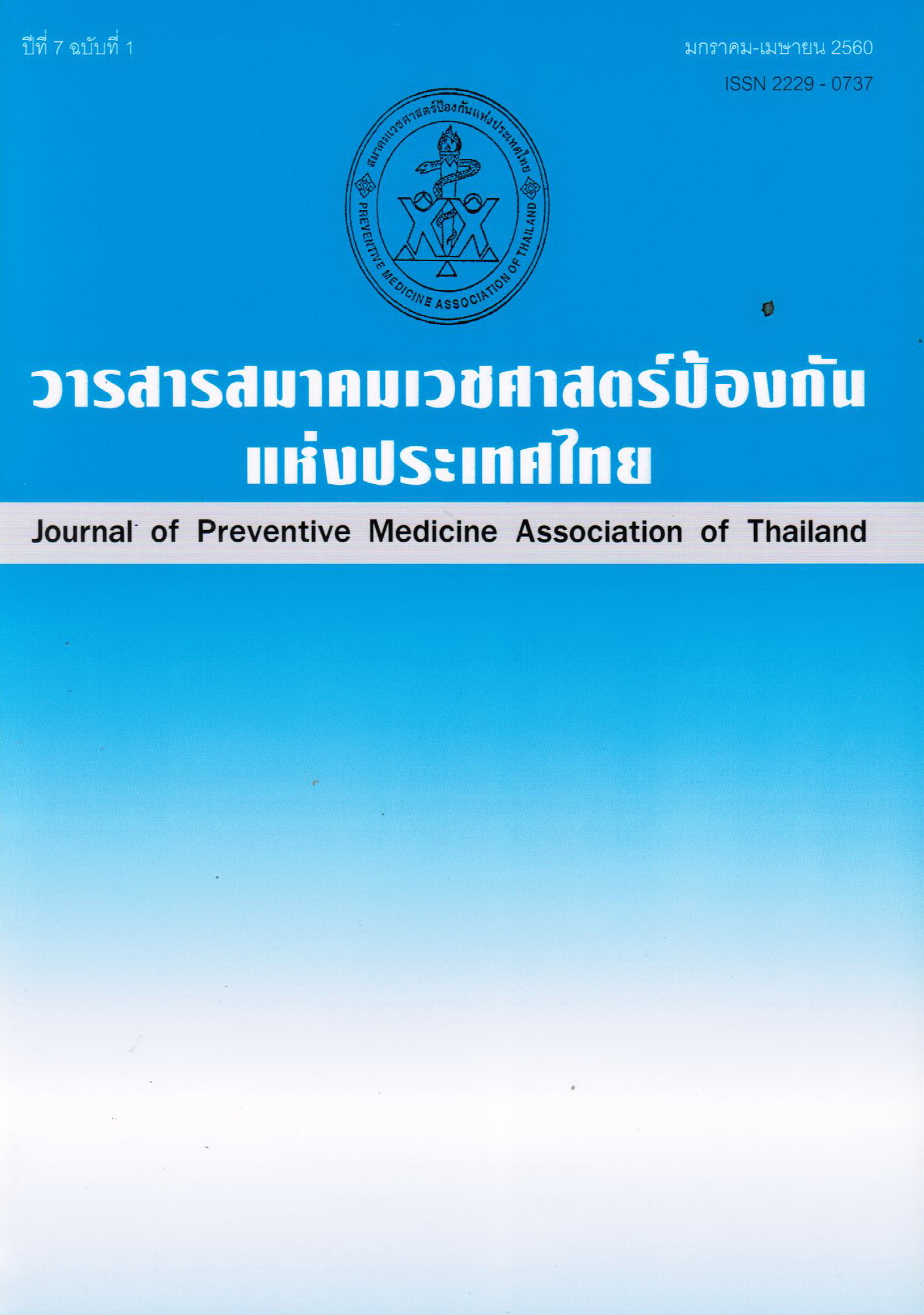การเตรียมความพร้อมรับมือต่อเหตุการณ์แผ่นดินไหว
คำสำคัญ:
ความตระหนักรู้, การเตรียมรับมือ, แผ่นดินไหวบทคัดย่อ
แผ่นดินไหว เป็นภัยพิบัติที่ก่อให้เกิดความสูญเสียทั้งต่อชีวิตและทรัพย์สินในหลายประเทศทั่วโลก หลายประเทศที่เผชิญกับเหตุการณ์แผ่นดินไหวตลอดเวลา ได้มีการเตรียมพร้อมให้กับประชาชนตั้งแต่วัยเด็ก โดยการให้ความรู้ มีแนวทาง และฝึกปฏิบัติ เพื่อให้เกิดทักษะในการรักษาชีวิตให้ปลอดภัยจากภัยพิบัติดังกล่าว แต่ยังมีอีกหลายประเทศที่ไม่เคยเผชิญกับเหตุการณ์แผ่นดินไหว หรือเคยแต่ระดับความถี่และระดับความรุนแรงของเหตุการณ์ไม่ได้ส่งผลกระทบต่อการใช้ชีวิตประจำวัน เช่น ประเทศไทย จึงไม่ได้เน้นและให้ความสำคัญกับการเตรียมความพร้อมและสร้างความตระหนักรู้ให้กับประชาชนในการเผชิญกับเหตุการณ์ดังกล่าวอย่างจริงจัง ผลที่ตามมาคือ เกิดความสูญเสียอย่างมากในวงกว้าง ดังนั้นการสร้างความตระหนักรู้ในการ
เตรียมพร้อมเพื่อการรับมือต่อการเกิดเหตุการณ์แผ่นดินไหวให้กับประชาชนจึงเป็นเรื่องสำคัญและต้องรีบดำเนินการ เพราะแผ่นดินไหวเป็นภัยพิบัติทางธรรมชาติที่ไม่สามารถหลีกเลี่ยงได้ แต่สามารถลดความสูญเสียได้หากมีความพร้อมในการรับมือและปฏิบัติตนเมื่อเผชิญกับเหตุการณ์ดังกล่าว
เอกสารอ้างอิง
2. ฐิติพร สินสุพรรณ, พรรณวดี สมบูรณ์, ชนิดาภา ยุกตะทัต. การลดความเสี่ยงจากภัยพิบัติสู่การพัฒนาที่ยั่งยืน. กรุงเทพมหานคร: สำนักงานโครงการพัฒนาแห่งสหประชาชาติสำนักงานประเทศไทย; 2557.
3. Centre for Research on the Epidemiology of Disasters (CRED). United Nations Office for Disaster Risk Reduction. 2015 Disasters in numbers. UNISDR [online] 2016 [cited 2016 Dec 1]. Available from: https://www.unisdr.org/we/inform/publications/47804/
4. Statista. Countries with the most earthquakes 1900-2016. The Statistics Portal [online] 2016 [cited 2016 Dec 1]. Available from: https://www.statista.com/statistics/269648/number-ofearthquakes-by-country/
5. โสภาพรรณ รัตนจีนะ. การลดความเสี่ยงจากสาธารณภัย. กรุงเทพมหานคร: โรงพิมพ์ชุมนุมสหกรณ์การเกษตรแห่งประเทศไทย; 2556.
6. Government of Japan, Cabinet office. Disaster management in Japan. Tokyo : Director general for disaster management. [online] 2016 [cited 2016 Dec 1]. Available from: http://www.bousai.go.jp/
7. Greer A. Earthquake preparedness and response: comparison of the United States and Japan. Leadership Manage Eng 2012; 12(3): 111-25.
8. Suganuma K. Recent trends in earthquake disaster management in Japan. Quarterly Review 2006; (19): 91-106.
9. สำนักงานเขตเมกุโระ, แผนกป้องกันภัยพิบัติ สำนักงานควบคุมภยันตราย เขตเมกุโระ. คู่มือการรับมือแผ่นดินไหว ฉบับย่อ. (แปลจากภาษาญี่ปุ่น โดยศูนย์นักศึกษาต่างชาติ สถาบันเทคโนโลยีแห่งโตเกียว). โตเกียว: มูลนิธิส่งเสริมความร่วมมือระหว่างประเทศแห่งเขตเมกุโระ (MIAA); 2550.
10. America’s Prepare Athon. EARTHQUAKE Be Smart. Know your hazard. How to Prepare for an Earthquake. [online] [cited 2016 Dec 1]. Available from: https://community.fema.gov/hazard/earthquake-en_us/be-smart?lang=en_US/
11. U.S. Geological Survey. United States Earthquakes 1990-2012. Earthquake Statistics [online] [cited 2016 Dec 1]. Available from: https://earthquake.usgs.gov/earthquakes/browse/stats.php/
12. Federal Emergency Management Agency. 2011 FEMA Central States Disaster and Earthquake Preparedness Survey Report. FEMA [online] 2012 [cited 2016 Dec 1]. Available from: https://www.fema.gov/media-library/assets/documents/28886/
13. Building Seismic Safety Council for the Federal Emergency Management Agency of the Department of Homeland Security. Homebuilders’ guide to earthquake resistant design and construction. Washington DC: National Institute of Building Sciences; 2006.
14. Federal Emergency Management Agency. Are You Ready? An In-depth Guide to Citizen Preparedness 2014. FEMA [online] 2011 [cited 2016 Dec 1]. Available from: https://www.ready.gov/document/are-you-ready-depth-guide-citizen-preparedness/
15. Federal Emergency Management Agency/U.S. Department of Homeland Security. Earthquake Safety Checklist 2014. FEMA [online] 2014 [cited 2016 Dec 1]. Available from: https://www.fema.gov/ko/media-library/assets/documents/3234/
16. Federal Emergency Management Agency. Earthquake safety at home. FEMA [online] 2016 [cited 2016 Dec 1]. Available from: https://www.fema.gov/earthquake-safety-home/
17. Global Facility for Disaster Reduction and Recovery. Disaster risk reduction and emergency management in Armenia. Washington DC: World Bank; 2009.
18. Balassanian S, Manukian A. Seismic risk on the territory of the city of Yerevan, Armenia. Issue in urban earthquake risk. 1st ed. Istanbul : Kluwer Academic Publishers; 1993.
19. Ornthammarath T, Warnitchai P, Worakanchana K, Zaman S, Sigbjörnsson R, Giovanni Lai C. Probabilistic seismic hazard assessment for Thailand. Bull Earthquake Eng 2010; 9: 367-94.
20. กระทรวงทรัพยากรธรรมชาติและสิ่งแวดล้อม, กรมทรัพยากรธรณี. รายงานสถานการณ์ธรณีวิทยาและทรัพยากรธรณี พ.ศ. 2558. กรุงเทพมหานคร: บริษัท เอเชีย แปซิฟิค มัลติมีเดีย; 2558.
21. ราชกิจจานุเบกษา. กฎกระทรวง. กำหนดการรับน้ำหนัก ความต้านทาน ความคงทนของอาคารและพื้นดินที่รองรับอาคารในการต้านทานแรงสั่นสะเทือนของแผ่นดินไหว พ.ศ. 2550. เล่ม 124 ตอนที่ 86 ก 30 พฤศจิกายน 2550; 4-15.
22. กระทรวงมหาดไทย, กรมป้องกันและบรรเทาสาธารณภัย. แผนแม่บทป้องกันและบรรเทาภัยจากแผ่นดินไหวและอาคารถล่ม. นนทบุรี: ชุมนุมสหกรณ์การเกษตรแห่งประเทศไทย; 2557.
23. ราชกิจจานุเบกษา. พระราชบัญญัติป้องกันและบรรเทาสาธารณภัย พ.ศ. 2550. เล่ม 124 ตอนที่ 52 ก 7 กันยายน 2550; 1-23.
24. Bissell RA, Pinet-Peralta LM, Levy M. Evidence of the effectiveness of health sector preparedness in disaster response: The example of four earthquakes. Fam Community Health 2004; 3(27): 193-203.
ดาวน์โหลด
เผยแพร่แล้ว
รูปแบบการอ้างอิง
ฉบับ
ประเภทบทความ
สัญญาอนุญาต
บทความที่ลงพิมพ์ในวารสารเวชศาสตร์ป้องกันแห่งประเทศไทย ถือเป็นผลงานวิชาการ งานวิจัย วิเคราะห์ วิจารณ์ ตลอดจนเป็นความเห็นส่วนตัวของผู้นิพนธ์ กองบรรณาธิการไม่จำเป็นต้องเห็นด้วยเสมอไป และผู้นิพนธ์จะต้องรับผิดชอบต่อบทความของตนเอง






